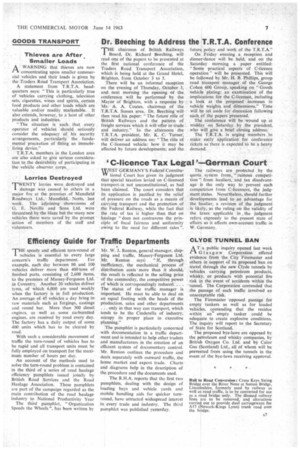Efficiency Guide for Traffic Departments
Page 9

If you've noticed an error in this article please click here to report it so we can fix it.
THE speedy and efficient turn-round of vehicles is essential to every large concern's traffic department. For example, each day between 80 and 100 vehicles deliver more than 400 tons of finished parts, consisting of 2,600 items, to thc premises of Massey-Ferguson Ltd. in Coventry. Another 20 vehicles deliver tyres, of which 6.000 are used weekly when the factory is in full production. An average of 45 vehicles a day bring in raw materials such as forgings, castings and round bar. More than 300 diesel engines, as well as some carburetted engines, are received by road every day. The factory has a daily output of some 400 units which has to be cleared by road.
With such a considerable movement of traffic the turn-round of vehicles has to be rapid and all transport units must be fully employed on transport for the maximum number of hours per day.
An account of the methods used to solve the turn-round problem is contained in the third of a series of road haulage efficiency pamphlets issued jointly by British Road Services and the Road Haulage Association. These pamphlets are part of the campaign regarded as the main contribution of the road haulage industry to National Productivity Year The third pamphlet, "Organization Speeds the Wheels ", has been written by
Mr. W. J. Renton, general manager, shipping and traffic, Massey-Ferguson Ltd. Mr. Renton say: "If, through inefficiency, the mechanical process of distribution costs more than it should, the result is reflected in the selling price of the commodity, the competitive power of which is correspondingly. reduced. . . . The status. of the traffic manager is important. He must be able to deal on an equal footing with the heads of the production, sales and other departments . . only in that way can transport, which tends to be the Cinderella of industry, occupy its proper place in executive planning."
The pamphlet is particularly concerned with documentation in a traffic department and is intended to help other traders and manufacturers in the creation of an efficient system of documentary control. Mr. Renton outlines the procedure and deals separately with outward traffic, the home market and export trade. Charts and diagrams help in the description of the procedure and the documents used.
The R.H.A. reports that the first two pamphlets, dealing with the design of loading bays and vehicle yards and mobile handling aids for quicker turnround, have attracted widespread interest in every trade and industry. The third pamphlet was published yesterday.
























































































































































